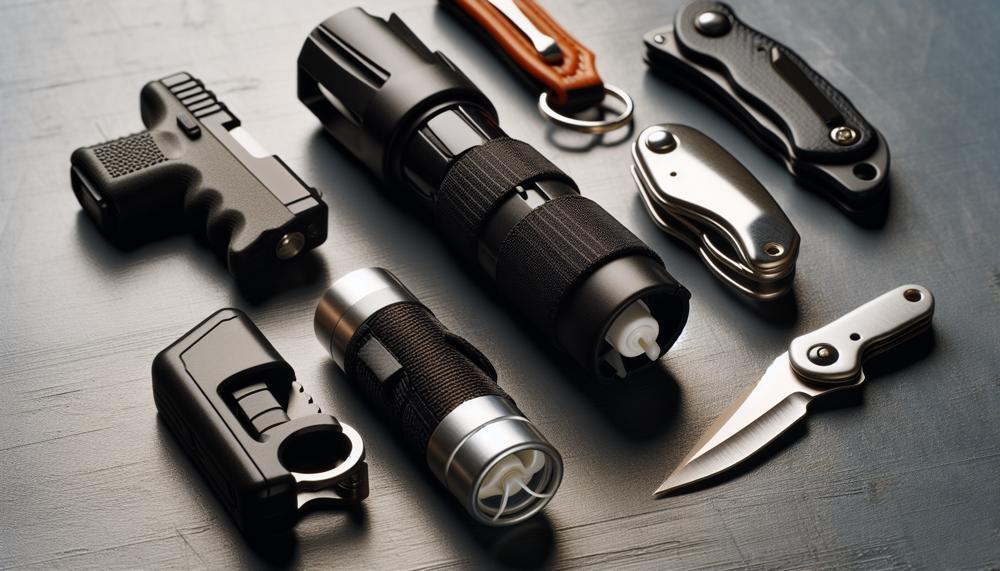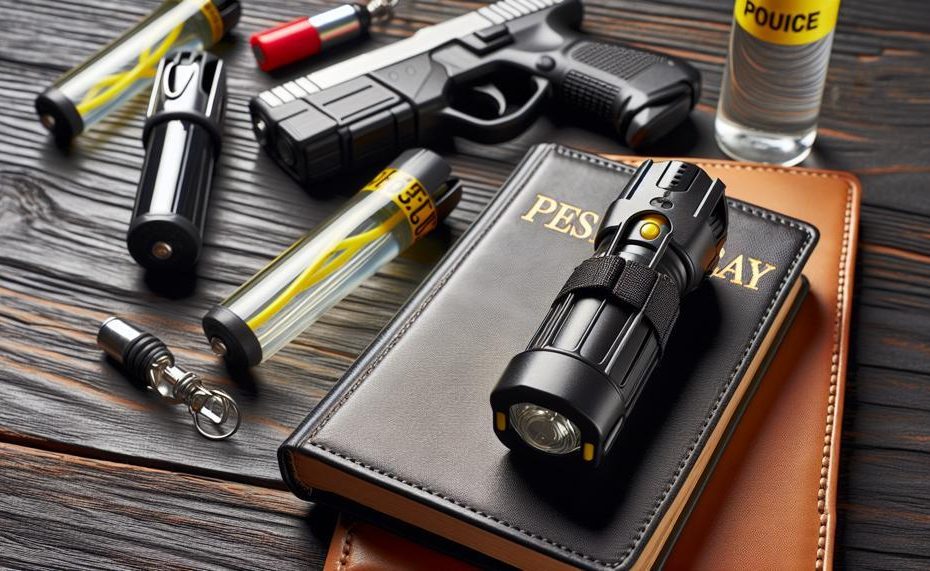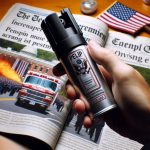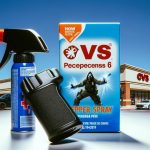Imagine this: you’re walking alone at night. You’re enjoying the peacefulness of the empty streets.
Suddenly, a chill runs down your spine as you sense someone following you. Your heart races with fear as you reach for your self-defense weapon – but which one should you choose?
Pepper spray or a taser?
Both have advantages and disadvantages. It’s crucial to understand them before making a decision that could potentially save your life.
In this blog post, we will compare pepper spray and taser as self-defense options. We’ll dissect the key factors to consider when selecting your ultimate protection tool. These factors include effectiveness and ease of use.
Whether you’re an experienced self-defense expert or just starting to think about your safety, read on. Discover which option may be more suitable for your needs.
Contents
Price
When it comes to self-defense, choosing between pepper spray and a taser can be a financial decision. It is also a personal one. The price difference between these two weapons is significant. Pepper spray ranges from $10 to $50. Tasers cost anywhere from $300 to $1,000. However, when comparing the costs of these two self-defense options, there are several crucial factors to consider.
The initial cost of pepper spray is substantially lower than that of a taser. However, it’s essential to keep in mind that additional expenses may be required. For example, refills are often necessary after using pepper spray, which can add up over time.
On the other hand, tasers only need a battery recharge or replacement (if not rechargeable). This makes them a more affordable option in the long run.
Additionally, both pepper spray and tasers have long lifespans. However, they may require maintenance to remain effective. It’s also worth noting that pepper spray has a longer range than tasers but requires more accuracy when being used.
Legal restrictions on the use and carry of these self-defense weapons must also be taken into consideration. Pepper spray is generally the least restricted option in the US. However, some states may limit both pepper spray and tasers.
Life Span
Pepper spray and tasers are popular self-defense tools. They are commonly used to protect individuals in dangerous situations.
However, it is important to understand how long these devices can be relied upon before they need to be replaced.
Life Span of Pepper Spray:
Pepper spray contains a chemical compound called capsaicin, which is derived from chili peppers. This compound causes the burning sensation, temporary blindness, and difficulty breathing when it comes into contact with the eyes and skin.
The strength and effectiveness of pepper spray can vary depending on the brand and concentration. Typically, it has a shelf life of 3-4 years from the date it was manufactured.
Life Span of Tasers:
Tasers, also known as stun guns, use electricity to incapacitate an attacker. They are powered by batteries and usually have a lifespan of about 2 years before needing to be replaced.
Some rechargeable models may last longer, but this depends on how frequently they are used and recharged.
Maintenance and Replacement Costs:
Consider the lifespan of these self-defense tools. Also, factor in maintenance and replacement costs.
Pepper spray canisters may need to be replaced after each use. It also depends on their expiration date. Some may need replacing every few years. Stun guns may need regular battery replacements or recharging. This can add up over time.
Ease of Use
When it comes to ease of use, pepper spray is typically considered more user-friendly for self-defense than tasers.
This is due to several factors, including distance, legal implications, and accessibility.
Pepper spray allows the user to defend themselves from a safe distance of 10-12 feet, which means they do not have to get too close to the attacker. In contrast, tasers require closer proximity. They may not be as effective on individuals under the influence of drugs or alcohol.
Pepper spray is more widely available for purchase and has fewer restrictions compared to tasers in terms of legal implications. However, it is important to note that laws regarding the use and possession of pepper spray vary by state and country. Therefore, it is crucial to be familiar with local regulations.
Furthermore, most modern pepper sprays come equipped with safety features. These prevent accidental discharge and minimize any effects on the user. However, it is still recommended to receive proper training on how to safely and effectively use a taser.
There may be age restrictions when purchasing pepper spray or a taser. Generally, pepper spray is more easily accessible and at a lower cost compared to tasers, which may require specialized vendors and higher costs.
Distance of Efficacy
Pepper spray and tasers are commonly used for self-defense. People often judge their effectiveness by their maximum range.

While pepper spray typically has a range of 6-12 feet, tasers can reach up to 15 feet.
Speed of Efficacy
When it comes to self-defense weapons, the speed of efficacy is a crucial factor to consider. This refers to how quickly the weapon takes effect in order to incapacitate an attacker. Pepper spray and tasers are two common options, but they differ significantly in terms of speed of efficacy.
Pepper spray
Pepper spray, for instance, can take effect almost immediately when sprayed directly into the face. The pepper extract causes intense pain and temporary blindness upon contact with the eyes, nose, and respiratory system.
This reaction can cause an attacker to close their eyes, cough, and tear up, making it difficult for them to continue attacking.
The effects of pepper spray can last for about 30 minutes or more, giving the user ample time to escape from danger.
Tasers
In comparison, tasers use electrical currents to disrupt the body’s neuromuscular system. This results in temporary muscle incapacitation.
They have a longer range than pepper spray. However, the electric shock needs time to travel through the body to cause muscle contractions. So, they may take slightly longer to take effect. However, once the taser takes effect, it can immobilize an attacker for several seconds, providing the user with enough time to escape.
Overall, both pepper spray and tasers are effective self-defense weapons with unique strengths and limitations.
When considering the speed of efficacy, pepper spray may have a slight advantage due to its immediate effects upon contact. Both options can effectively incapacitate an attacker. They also provide the user with enough time to flee from danger.
Ultimately, when choosing between these two self-defense weapons, consider personal preferences and specific circumstances.
Potential for Inflicting Lasting Damage
When it comes to using pepper spray and tasers as self-defense weapons, there are potential risks and long-term effects that must be considered. These include:
- Innocent bystander harm: Due to their aerosol nature, pepper spray and tasers can easily affect anyone in the vicinity, potentially causing unintended harm and legal consequences.
- Respiratory problems: Exposure to pepper spray can lead to respiratory issues such as difficulty breathing, coughing, and wheezing. In severe cases, it may even trigger asthma attacks or other allergic reactions.
- Skin irritation: Contact with pepper spray can result in skin irritation, redness, and burning sensations. Repeated exposure can lead to more serious skin conditions.
- Temporary blindness: By irritating the eyes and causing them to close, pepper spray can cause temporary blindness. This poses a danger for both the victim and attacker.
- Permanent damage: Prolonged exposure to pepper spray can cause permanent damage to an attacker’s eyes and respiratory system.
- Potential for Inflicting Lasting Damage: Despite being designed as non-lethal weapons, tasers still pose a risk of physical injury due to close contact with the attacker and potential physical confrontation.
- Psychological effects: Frequent use of tasers can have psychological effects such as anxiety, depression, and post-traumatic stress disorder (PTSD).
- Cardiac arrest: In rare cases, tasers have been known to trigger cardiac arrest and even death in individuals with pre-existing heart conditions.
When considering using pepper spray or tasers for self-defense, it is crucial to keep potential risks and long-term effects in mind. Proper training and education on their use can help mitigate these risks. It can also ensure responsible usage in dangerous situations.
Safety
When it comes to safety, both pepper spray and tasers have their own advantages and limitations.
However, in general, pepper spray can be considered a more viable option due to its wider range, lower cost, and fewer legal implications.
| Pepper Spray | Taser |
| Can reach up to 10-12 feet | Requires closer proximity to attacker |
| Less expensive (typically $10-$50) | More expensive (typically several hundred dollars) |
| No legal implications in most cases if used responsibly | Likely to require proper training and understanding of laws for safe and effective usage |
| Can cause temporary discomfort and inconvenience without causing permanent harm | Potential for lasting damage or even cardiac arrest if used improperly or against certain individuals (such as those under the influence of drugs or alcohol) |
| Can also act as a deterrent against aggressive animals following local laws and regulations |
While both pepper spray and tasers carry potential risks and should be used with caution, pepper spray may be a safer option for those looking for a self-defense tool.
However, it’s important to remember that responsible use of any self-defense tool requires proper training and understanding of laws. This not only ensures the safety of oneself but also of others.
In fact, I remember when I first started carrying pepper spray for protection, I made sure to educate myself on its proper usage and legal implications.
It gave me peace of mind knowing that I was equipped with a tool that could protect me without causing permanent harm.
Level of Discretion
Choosing the right self-defense weapon requires careful consideration of various factors. These include laws, regulations, and personal preferences.
This section will delve into the levels of discretion needed for pepper spray and tasers, and offer tips for selecting between the two.
Determining the Required Level of Discretion:
When it comes to discretion, pepper spray typically requires a lower level compared to tasers. This is due to its ability to be used from a distance, providing a safer gap between the user and the attacker. Moreover, pepper spray is more affordable and widely available than tasers, making it a more accessible option for those seeking a self-defense tool.
On the other hand, tasers may demand a higher level of discretion due to their close-range usage and potential legal implications. Proper training is crucial for safe and responsible taser use. Laws and regulations regarding their possession and usage vary by state and country. It’s imperative to thoroughly research and understand these laws before purchasing or using a taser.
Factors to Keep in Mind:
When deciding between pepper spray and tasers, several considerations must be taken into account. These include:
- Legal limitations: As mentioned earlier, laws and regulations concerning the possession and use of pepper spray and tasers differ by state and country. Thoroughly researching these laws is essential before making a decision.
- Personal comfort: Some individuals may feel more at ease using one weapon over the other. It’s crucial to choose a self-defense tool that you feel confident using in case of an emergency.
- Potential threats: Consider your surroundings and potential attackers when selecting between pepper spray and tasers. For instance, if you reside in an area with aggressive animals, pepper spray may be a better option as it can also act as a deterrent against animals.
- Multiple attackers: Both pepper spray and tasers have limitations when it comes to defending against multiple attackers. Pepper spray has a range of 10-12 feet, while tasers require closer proximity. This should be kept in mind when assessing the potential risk of facing multiple attackers.
In conclusion, choosing the appropriate self-defense weapon requires careful consideration of various factors. It’s crucial to understand and abide by laws and regulations, consider personal comfort and potential threats, and keep the limitations of each weapon in mind before making a decision.
Legality
When choosing between buying pepper spray or a taser for self-protection, there are several legal factors to consider.
These include the laws and regulations surrounding the purchase, possession, and use of each weapon, as well as any restrictions or permits required in your state.
Pepper spray
Pepper spray is permitted in most states, but it is essential to research the specific laws and regulations in your state before purchasing or using it for self-defense. Some states may have age restrictions or require permits for purchasing pepper spray. Others may limit its use in certain public areas.
It is also crucial to follow safety guidelines when using pepper spray, as improper use can result in legal consequences.
Tasers
On the other hand, tasers are regulated differently in each state and may have stricter laws than pepper spray. Some states may require a license or permit to own a taser, while others may have age restrictions.
The circumstances under which you can legally use a taser for self-defense may also vary among states.
Limitations
While pepper spray and tasers can be effective self-defense tools, they also have their drawbacks. Below are the top 10 limitations to keep in mind when considering these weapons for protection:
- Limited Range: Pepper spray has a range of 10-15 feet, while tasers can reach up to 25 feet. This means that if an attacker is outside of this range, the weapon may not be effective in stopping them.
- Wind and Weather: Pepper spray can be affected by wind and weather conditions, making it less reliable in certain situations. For example, strong winds can blow the spray back into your own face, causing discomfort and hindering your ability to defend yourself.
- Accuracy: Both pepper spray and tasers require a certain level of accuracy to be effective. If you are not experienced in using these weapons, you may struggle to hit your target accurately and reduce the weapon’s effectiveness.
- One-Time Use: Pepper spray and tasers typically can only be used once before needing to be replaced, limiting their usefulness as a long-term self-defense tool.
- Potential Risks: While pepper spray and tasers are considered non-lethal, there is still a risk of injury or harm when using them. Pepper spray can cause temporary blindness and respiratory issues, while tasers can cause muscle injuries or even cardiac arrest in some cases.
- Legal Implications: The use of pepper spray or tasers for self-defense can have legal implications as laws vary by state and country. It’s important to research and understand these laws before purchasing and carrying these weapons.
- Personal Factors: Personal factors such as comfort level and lifestyle should also be considered when choosing between pepper spray and tasers for self-defense. For example, some people may feel more comfortable carrying one over the other, while others may have a lifestyle that makes one option more suitable for them.
- Effectiveness Against Multiple Attackers: Pepper spray and tasers are not as effective against multiple attackers, as they can only be used on one person at a time. This means that in situations with more than one attacker, these weapons may not provide sufficient protection.
- Limited Use: As mentioned, pepper spray and tasers can typically only be used once before needing to be replaced. This limitation makes them less suitable for long-term self-defense compared to other weapons such as firearms.
- Distance Restrictions: Both pepper spray and tasers require close proximity to the attacker to be effective, which can be a disadvantage in certain situations. For example, if an attacker is already too close, it may not provide enough time to use the weapon effectively.
To ensure your safety and protection, consider all of these limitations. Choose the self-defense tool that best fits your needs and lifestyle. While pepper spray and tasers can be useful in certain situations, they may not always be the most effective option for everyone.
Conclusion
After weighing the various factors, such as price, durability, ease of use, range and speed of effectiveness, potential for harm, and safety, it is clear that choosing between pepper spray and a taser for self-defense can be a tough decision.
While both options have their strengths and limitations, pepper spray may offer a more affordable and safer choice for those seeking a reliable self-defense tool. However, it is crucial to note that responsible usage of any weapon requires proper training and knowledge of laws.
Always prioritize your safety and seek proper education on the use of these weapons before making a potentially life-saving choice in a dangerous situation.





